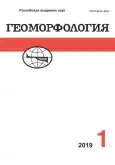Mathematical modeling of the development of the long profile of a deluvial slope
- Authors: Salugin A.N.1, Kulik A.V.1
-
Affiliations:
- FSC of Agroecology RAS
- Issue: No 1 (2019)
- Pages: 59-65
- Section: Scientific Research Methods
- URL: https://journals.eco-vector.com/0435-4281/article/view/11609
- DOI: https://doi.org/10.31857/S0435-42812019159-65
- ID: 11609
Cite item
Abstract
The process of formation of gentle deluvial (dominated by sheet erosion) slopes under the influence of anthropogenic load is investigated using a deterministic balance model in a 2D formulation. It is shown that the non-linear erosion model as a diffusion equation in partial derivatives with boundary conditions makes it possible to adequately reflect the dynamics of sheet erosion. The physical aspects of mass transfer in a laminar flow are considered, taking into account the mechanisms of separation and transport of soil particles in connection with the concept of critical velocity. The evolution of the profile of a deluvial slope is investigated. The results of the numerical experiment were used to analyze the mechanism of transfer of erosion products and the formation of profiles. The concept of diffusion-balance modeling is expanded by numerical, as well as computational experiments. Taking into account the detected high adequacy of the model, it can be used to describe the evolution of deluvial slopes.
Full Text
About the authors
A. N. Salugin
FSC of Agroecology RAS
Author for correspondence.
Email: anastasiya-kulik@yandex.ru
Russian Federation, Volgograd
A. V. Kulik
FSC of Agroecology RAS
Email: anastasiya-kulik@yandex.ru
Russian Federation, Volgograd
References
- Trofimov A.M. Matematicheskoe modelirovanie v geomorfologii sklonov (Mathematical mod-eling in slope geomorphology). Kazan: Kaz. Un-t (Publ.), 1983. 218 p.
- Garshinev E.A. Jerozionno-gidrologicheskij process i lesomelioracija (The erosional and hy-drological process and the forest improvement). Volgograd: VNIALMI (Publ.), 1999. 196 p.
- Goncharov V.N. Osnovy dinamiki ruslovyh potokov (The basics of dynamics of open surface channels). Leningrad: Gidrometeoizdat (Publ.), 1954. 452 p.
- Pozdnjakov A.V. Dinamicheskoe ravnovesie v rel'efoobrazovanii (Dynamic equilibrium in the morphogenesis). Moscow: Nauka (Publ.), 1988. 208 p.
- Nesterenko Ju.M., Bondarenko I.I., Nesterenko M.Ju., and Vlackij V.V. Mathematical model of surface runoff formation and its program realization. Vest. Orenb. Univ. 2010. No. 10 (116). P. 131–137. (in Russ.)
- Rulev A.S. and Juferev V.G. Mathematical and geomorphological modeling of the erosion landscapes. Geomorfologiya (Geomorphology RAS). 2016. No. 3. P. 36–45. (in Russ.)
- Kulik K.N., Salugin A.N., and Garshinev E.A. Mathematical modelling processes of erosion soils. Russ. Agric. Sci. 2004. No. 6. P. 33–36. (in Russ.)
- Salugin A.N. Behavior of nonequilibrium arid ecosystems and its prediction. Ecologiya. 2007. No. 4. P. 41–45. (in Russ.)
- Salugin A.N. and Salugina L.N. Matematicheskaja jekologija sklonovyh system (Mathematical ecology of slope systems). Volgograd: VolgGASU (Publ.), 2007. 112 p.
- Hirano M. Green’s Function of Mass Transport and the Landform Equation. Concepts and Modelling in Geomorphology: International Perspectives. Tokyo, 2003. P. 101–114.
- Culling W.E.H. Soil creep and the development of hillside slopes. J. Geol. 1963. Vol. 71. No. 2.
- Prigozhin I. Ot sushhestvujushhego k voznikajushhemu: Vremja i slozhnost' v fizicheskih naukah (From Being to Becoming: Time and Complexity in the Physical Sciences). Ju.L. Klimontovich. Ed. Moscow: Nauka (Publ.), 1985. 327 p.
- Tihonov A.N. and Samarskij A.A. About uniform differential schemes. Zhur. Vych. Mat. i Mat. Fiz. 1961. Vol. l. No. 1. P. 55–63. (in Russ.)
- Ljather V.M. and Prudovskij A.M. Gidravlicheskoe modelirovanie (Hydraulic modeling). Moscow: Energoatomizdat (Publ.), 1984. 392 p.
- Devdariani A.S. Matematicheskij analiz v geomorfologii (The mathematical analysis in geo-morphology). Moscow: Nauka (Publ.), 1967. 156 p.
- Hirano M. Quantitative morphometry of fault with reference to the Hira Mountains, Central Japan. Jap. Geol. and Geogr. 1972. Vol. 42. No. 1–4. P. 85–100
- Bahvalov N.S. Chislennye metody (Numerical methods). Moscow: Nauka (Publ.), 1987. 48 p.
Supplementary files








